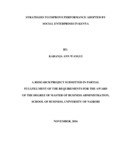| dc.description.abstract | Organizations are made up of bundles of resources which are obtained from the environment and are there of disposed to the environment after value addition. Organizations therefore operate in open systems where a change in one sub system causes subsequent change in another subsystem. In a bid to remain relevant in their environment, social enterprises have to craft strategies. These strategies are used to ensure growth of the organizations. In some cases, the survival of some organizations is dependent on strategies. The study was carried out to determine strategies to improve performance adopted by social enterprises in Kenya. This study used the cross sectional survey to understand strategies adopted by Social Enterprises in Kenya as well as to establish if such strategies influences performance of the Social enterprises in Kenya. The study used both primary data and secondary data. The primary data was collected by use of a semi structured questionnaire. These questionnaires were administered to different strategic managers within the Social impact enterprises. The questionnaires were sent to 70 respondents, of which 31 responded, representing a response rate of 44%. All the Social enterprises surveyed agreed that they have programs elaborating their strategic agendas. These formal programs formed the secondary data. Internal, external and environmental factors considered to be most influential on the strategic orientation of the social enterprises were; technology, management and resources. The study also found out that PESTEL and SWOT analysis were the most common tools of analysis used in strategic planning amongst these social enterprises. However, they were limited by the fact that they did not offer a procedural way of strategy implementation. Findings revealed that the private sector was the greatest competitor of social enterprises. The study findings established that the social enterprises used planned strategy, niche market competitive strategy and dominant market competitive strategies. These findings concurred to what other scholars have found out in their past studies with regard to the influence of strategy and performance; that social impact enterprises engaged in formal strategic planning outperform those that engage in informal strategic planning. The study concludes that the relationship between strategic planning and performance are inconclusive. The study recommends that every social enterprise has its own strength, and weakness. More over each market has its own opportunities and threats. None of the performance improvement strategies is suitable for all the market or even one market for at a particular period of time. The best right means towards achieving sustained organisational performance would be amending strategy when changes occur in the external environment. The study further recommends that for government to strengthen the capacity of social enterprises it ought to partner with financial institutions. The government can sign memorandum of understanding with financial institutions to inject capital into such investments as well as giving them direct participation in government procurement. The study identified the following research areas for future studies; firstly, that in-depth analysis of single Social impact enterprises would give room to understanding key underlying variables that may have been globally over shadowed by findings in this particular study, social enterprises have not been studied in relation to change management. | en_US |



